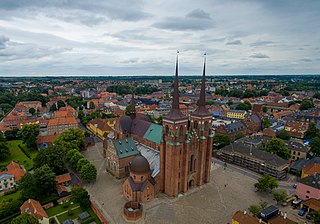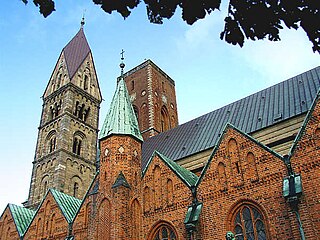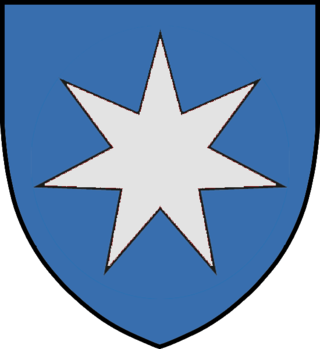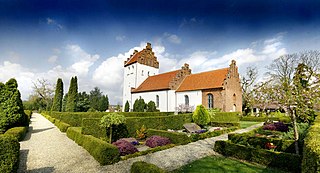
Frederick I was King of Denmark and Norway. He was the last Roman Catholic monarch to reign over Denmark and Norway, when subsequent monarchs embraced Lutheranism after the Protestant Reformation. As king of Norway, Frederick is most remarkable in never having visited the country and was never crowned as such. Therefore, he was styled King of Denmark, the Vends and the Goths, elected King of Norway. Frederick's reign began the enduring tradition of calling kings of Denmark alternatively by the names Christian and Frederick, which has continued up to the reign of the current monarch, Margrethe II.

Christopher of Bavaria was King of Denmark, Sweden (1441–48) and Norway (1442–48) during the era of the Kalmar Union.
Jöns Gerekesson was a controversial Archbishop of Uppsala, Sweden 1408–1421, and of Iceland 1426–1433 until he was murdered by being tied to a rock and drowned.

Roskilde Cathedral, in the city of Roskilde on the island of Zealand (Sjælland) in eastern Denmark, is a cathedral of the Lutheran Church of Denmark.

The former Diocese of Aarhus was a Roman Catholic diocese in Denmark, founded in the 10th century and dissolved during the Protestant Reformation. The diocese included the counties of Aarhus and Randers, the islands of Samsø and Tunø, and, after 1396, part of the county of Viborg.

The Church of Our Lady is the cathedral of Copenhagen. It is situated on the Frue Plads public square in central Copenhagen, next to the historic main building of the University of Copenhagen.

The former Diocese of Børglum was a Roman Catholic diocese in Northern Jutland, Denmark. It has also been referred to as the Diocese of Vestervig or the Bishopric of Vendsyssel. The diocese included Vendsyssel, Hanherred, Thy, and Mors.

The former Diocese of Odense was a Roman Catholic diocese in Denmark which included the islands of Funen, Langeland, Tåsinge, Lolland, Falster, Als, and Ærø. Its episcopal see was located in Odense at St. Canute's Cathedral.

The former Diocese of Ribe was a Roman Catholic diocese in Southern Jutland, Denmark. The diocese was established in 948, and dissolved in 1536 during the Protestant Reformation. Within the newly established protestant Church of Denmark, the Diocese of Ribe effectively replaced its Roman Catholic precursor.

Hvide was a medieval Danish clan, and afterwards in early modern era a Danish noble surname of presumably one surviving branch of leaders of that clan. Before the 16th century it was not used as a surname. It signified the color white.

The Diocese of Aarhus is one of 10 dioceses in the Church of Denmark, with headquarters in the city of Aarhus. The diocese covers a large district of northeast Jutland and comprises 14 deaneries, of which four cover the extent of Aarhus city itself.

Skjalm Hvide, was the Earl of Zealand in Denmark in the end of the Viking Age (793–1066) and up to his death. Skjalm's father was Toke Trylle, whose father was Slag, based on Absalon, a medieval account scanned, translated and published by Google.

The former Diocese of Roskilde was a diocese within the Roman-Catholic Church which was established in Denmark some time before 1022. The diocese was dissolved with the Reformation of Denmark and replaced by the Protestant Diocese of Zealand in 1537.

Constantin Marselis, or Constantijn Marselis, was a nobleman of the wealthy Dutch Marselis family.

Berte Skeel was a Danish noble, philanthropist and estate owner. She was the owner of Selsø Manor and co-founder of the Roskilde Adelige Jomfrukloster at Roskilde Kloster.
Svend I was the bishop of the Diocese of Aarhus between 1166 and 1191. Svend was a warrior and crusader who participated in numerous wars and raids with the Danish king. Contemporary historian Saxo Grammaticus mentions him as belonging to the inner circle of Valdemar I and Absalon. Svend may be best known for granting the Cistercian order large gifts of land which resulted in the founding of Øm Abbey by Mossø. It is known Svend was ordained bishop no later than 1166. Svend allowed Niels of Aarhus to be buried in Aarhus' St. Nicolai Cathedral after reports of miracles around the body and in connection with the burial.

Ove Bille was a Danish bishop and royal chancellor to three Danish kings John, Christian II and Frederick. He served as a chancellor for 21 years and was in 1520 rewarded with the bishopric of the Diocese of Aarhus. He was especially known for effective administration and strong defense of the Catholic Church. Following the Reformation in Denmar in 1536, Bille was treated more leniently than other Catholic bishops and was released already in 1537.
Tyge or Tuke or Tycho was bishop of the Diocese of Aarhus in Aarhus, Denmark. Tyge completed studies in Paris where he obtained a magister degree. Tyge became bishop of Aarhus with the support of Pope Urban IV and was involved in the ouster of Jacob Erlandsen, Archbishop of the Diocese of Lund. Bishop Tyge was known as a staunch supporter of the Danish kings and was for a period the de facto head of church in Denmark. Tyge died on Samsø on 23 November 1273. His successor was the former arch deacon Peder Aaby who had been Tyge's and king Eric V'a trusted supporter during the conflict with the church.

Margrete: Queen of the North is a 2021 Danish historical drama film, directed and co-written by Charlotte Sieling. The film is a fictionalised account of the 'False Oluf', an impostor who in 1402 claimed to be the deceased King Olaf II/Olav IV of Denmark-Norway, son of the title character Margrete I of Denmark.















